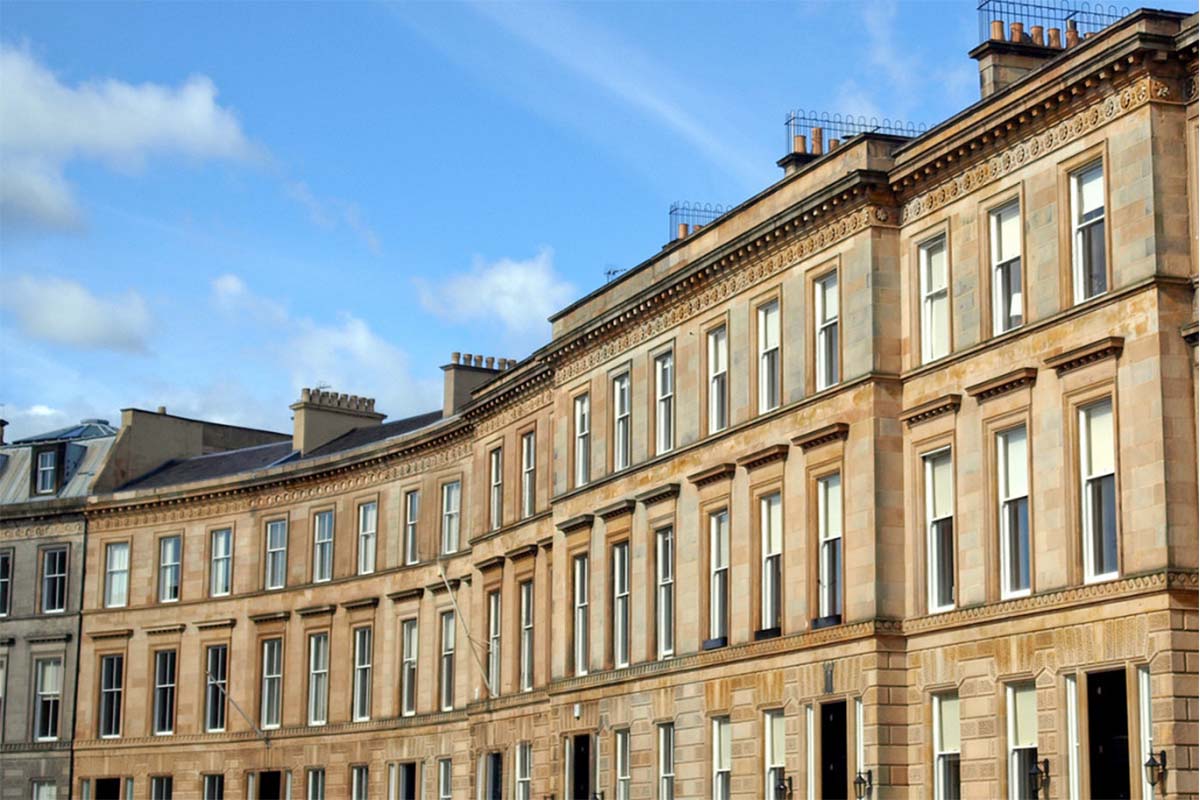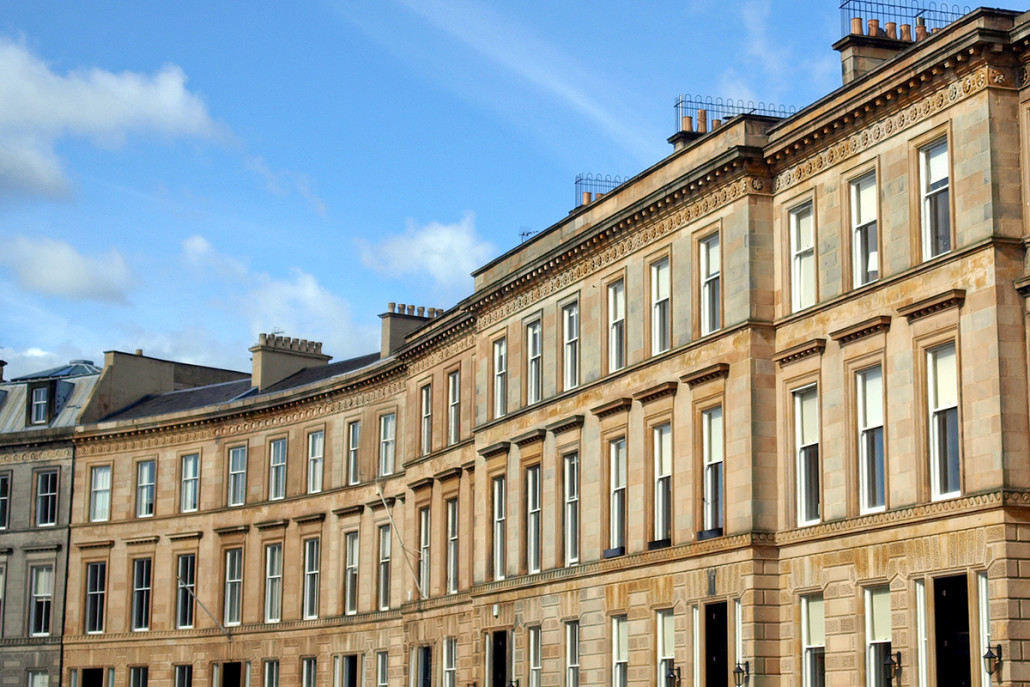An Architectural Tour of Glasgow West End
The West End of Glasgow is a great place to explore some of the city’s finest architecture. Many of Glasgow’s most extravagant buildings were constructed during the peak of its economic success during the Industrial Revolution, when the city was heralded the ‘Second City of the Empire’. As a result of the significant increase in trade at this time, Glasgow expanded rapidly and suddenly. The wealthy merchants and upper classes thus moved west, away from the industrial suburbs taking root in the east of the city. If you have time over the Christmas holidays, you should take the opportunity to visit some of the top sites listed here.
Great Western Terrace
Designed in 1869 by Alexander ‘Greek’ Thomson, Great Western Terrace is the original and most monumental of all the terraces situated along the tree-lined boulevard to the West of Byres Road and the Botanics. Constructed upon a platform and contained at both ends by railed walls, Thomson chose to forgo the common design concept of end and centre pavilions. Instead, he placed a three-storey pavilion six bays in from either end of the terrace, the purpose of which was to counter any visual sense of sagging by giving the illusion that the lower sections threaded directly through the taller pavilions.
The windows are simple in design, having been punched into the walls. Aside from the main cornice and the carved detail found in the four Greek Ionic columns encasing the doorways, decoration is more restrained than in any of Thomson’s other terrace designs. However, if you take a look at the wonderful cast-iron work, you will notice more pronounced decoration there. Considerably more decorative variety can be found internally, with grand imperial staircases and circular-domed light wells.
With the majority of the building having now been converted into residential apartments, the average property value on Great Western Terrace is currently £324,308. This has increased 1.69% from September 2016 and 7.86% in the past 12 months. The terrace enjoys a private outlook, screened by mature trees, and is separated from the main road by a single carriage road and terraced forecourt.
Kibble Palace
Covering an astonishing 2137 square metres, Kibble Palace is the UK’s biggest glasshouse and home to the national collection of tree ferns and tropical plants from five continents. Designed by John Kibble, the glass, steel and wrought iron structure was originally a private conservatory at Coulport on the shores of Loch Long. Kibble sold it to the Royal Botanic Institution of Glasgow in 1871. The glasshouse was re-erected in the West End in 1873 and used as a public meeting place and concert hall.
Kelvinside Hillhead Parish Church
Designed by architect James Sellers and inspired by the 13th-century Sainte-Chapelle in Paris, Kelvinside Hillhead Parish Church was completed in 1876 and is a category ‘A’ listed building. With its magnificent tall apse and stunning stained glass windows, this handsome church was designed in the French Gothic style, which was hugely popular at the time. Laying the foundations was particularly challenging and costly due to the church being built upon arches erected on top of a coal bed.
Glasgow University
Founded in 1451, the University of Glasgow University is the second oldest university in Scotland and the fourth oldest in the English-speaking world. Originally situated on the High Street, the University took up residence on the present Gilmorehill site in 1870 and was designed by architect George Gilbert Scott in the Gothic revival style.
The main buildings comprise two quadrangles connected by the iconic Cloisters – an impressive undercroft of fluted columns and transverse ribbed vaulting – above which is the grand Bute Hall. In 1887, the fanciful open spire was added to the University’s signature gothic bell tower.
Kelvingrove Art Gallery and Museum
This category ‘A’ listed building was constructed in 1901 as part of the Glasgow International Exhibition. The design of the building features a mixture of styles, with Spanish Baroque being the most prominent. The two main towers are particularly notable and were inspired by the pilgrimage church of Santiago de Compostela in the north east of Spain.
The focal point in the Central Hall of the museum is the magnificent walnut case-fronted organ by Lewis & Co. London. Visitors can enjoy daily organ recitals at 1pm on weekdays and 3pm at the weekend – a real treat to enjoy before or after exploring the museum’s 22 themed galleries.
Although most people nowadays enter from the Argyle Street entrance, the main entrance to the museum was originally from Kelvingrove Park on the opposite side. A popular urban myth around the construction of the museum is that it was built the wrong way round. Thankfully, this is untrue!
Park Circus
Forming part of a planned development of townhouses in the mid 19th century, the layout of the Park District is very similar to the spectacular neoclassical and Georgian design of Edinburgh’s New Town. Situated on top of Woodlands Hill and enjoying spectacular views overlooking Glasgow University, Kelvingrove Park and the north bank of River Clyde, it remains one of the most coveted residential areas of the city – the average price of residential property has increased almost 9% over the past year alone. The stone steps leading from Kelvingrove up to Park Terrace are spectacular and really good for the thigh muscles!
Vanilla Square – highly personal sales and lettings! Whether selling or letting property, you will always be liaising with one of our business partners, which makes our service that much more responsible and approachable. When you instruct us, your property will reach a wider audience as we are one of the few agents who are present on all the major property portals to offer sellers and landlords maximum exposure. If you’re looking to buy, sell, rent or lease your property, or you’re simply considering the idea, contact us by calling 0141 229 0210 or pop into our new office at 711 Great Western Road. One of our partners will be delighted to help and provide you with impartial, expert advice.





